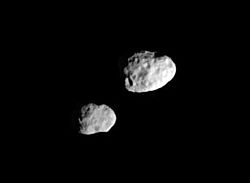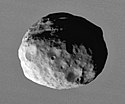Janus (księżyc)
 Zdjęcie Janusa na tle Saturna, wykonane przez sondę Cassini. | |
| Planeta | |
|---|---|
| Odkrywca | |
| Data odkrycia | 15 grudnia 1966 |
| Tymczasowe oznaczenie | S/1966 S 2, S/1980 S 1 |
| Charakterystyka orbity | |
| Półoś wielka | 151 450 km[1] |
| Mimośród | 0,0098[1] |
| Okres obiegu | 0,695 d[1] |
| Nachylenie do płaszczyzny Laplace’a | 0,165°[1] |
| Długość węzła wstępującego | 154,175°[1] |
| Argument perycentrum | 16,012°[1] |
| Anomalia średnia | 17,342°[1] |
| Własności fizyczne | |
| Wymiary | 203 × 185 × 152,6 km[2] |
| Masa | (1,8975 ± 0,0006) × 1018 kg[2] |
| Średnia gęstość | (0,63 ± 0,03) g/cm³[2] |
| Przyspieszenie grawitacyjne na powierzchni | 0,011–0,017 m/s²[2] |
| Okres obrotu wokół własnej osi | |
| Albedo | 0,71 ± 0,02 |
| Jasność obserwowana (z Ziemi) | 14m |
Janus (Saturn X) – księżyc Saturna. Nazwa pochodzi od Janusa, postaci z mitologii rzymskiej.
Odkrycie
Został odkryty w grudniu 1966 roku przez A. Dollfusa. Trzy dni później inny astronom, Richard Walker dokonał podobnej obserwacji, odkrywając księżyc Epimeteusz. Przez dwanaście lat nie było pewne, czy zaobserwowano w rzeczywistości jeden, czy dwa księżyce. Pewność co do istnienia ich obu przyniosły dopiero obserwacje sondy Voyager 1, która przeleciała przez system Saturna 12 listopada 1980 roku.
Orbita
Janus krąży ruchem prostym wokół Saturna po orbicie zbliżonej do kołowej, dzieląc ją w szczególny sposób z księżycem Epimeteuszem[3][4][5][6]. W 2006 roku odkryto również delikatne pasmo pyłu (pierścień) w pobliżu wspólnej orbity księżyców.
Bliskość Epimeteusza

Janus i nieco mniejszy Epimeteusz dzielą (prawie) tę samą orbitę, która znajduje się w przerwie między pierścieniami F i G Saturna. Promienie orbit tych księżyców różnią się zaledwie o 50 km. Ponieważ promień zarówno Epimeteusza jak i Janusa przekracza 50 km, wydawałoby się, że musi to nieuchronnie doprowadzić do zderzenia. Jednak podczas zbliżenia, wskutek oddziaływania grawitacyjnego między oboma ciałami, dochodzi do wymiany momentu pędu między nimi. Dzięki temu księżyc szybszy (o mniejszej orbicie) staje się księżycem wolniejszym (o większej orbicie), zanim dogoni współorbitalnego towarzysza. W ten sposób, paradoksalnie, przyciągające oddziaływanie grawitacyjne powoduje odepchnięcie się księżyców. W wyniku owej „wymiany orbit”, która nie jest ścisłą wymianą ze względu na różnicę mas, te dwa księżyce wcale się nie mijają. Największe zbliżenie wynosi ok. 10 tys. km i zachodzi co ok. 4 lata; w jego wyniku półoś wielka orbity Janusa maleje/rośnie o ok. 20 km, a Epimeteusza rośnie/maleje o 80 km.
Janus wraz z Epimeteuszem, krążąc po zewnętrznej stronie pierścienia F, oraz Prometeusz od wewnętrznej strony pełnią funkcję pasterskich księżyców tego pierścienia.
Kratery
Cztery nazwane kratery na powierzchni Janusa otrzymały swoje nazwy pochodzące z mitologii greckiej w 1982 roku[7].
| Krater | Pochodzenie nazwy |
|---|---|
| Castor | Kastor, bliźniak Polluksa |
| Idas | Idas, jeden z bliźniaków, kuzyn Kastora i Polluksa |
| Lynceus | Linkeus, jeden z bliźniaków, kuzyn Kastora i Polluksa |
| Phoibe | Fojbe, córka Leukipposa |
Zobacz też
- Chronologiczny wykaz odkryć planet, planet karłowatych i ich księżyców w Układzie Słonecznym
- Księżyce Saturna
Przypisy
- ↑ a b c d e f g Planetary Satellite Mean Orbital Parameters. Jet Propulsion Laboratory, 2013-08-23. [dostęp 2016-02-21]. (ang.).
- ↑ a b c d P.C. Thomas. Sizes, shapes, and derived properties of the saturnian satellites after the Cassini nominal mission. „Icarus”. 208 (1), s. 395-401, lipiec 2010. DOI: 10.1016/j.icarus.2010.01.025. (ang.).
- ↑ The Rotation of Janus and Epimetheus. [dostęp 2015-05-25]. (ang.).
- ↑ Theory of the rotation of Janus and Epimetheus. [dostęp 2015-05-25]. (ang.).
- ↑ Analytical description of physical librations of Saturnian coorbital satellites Janus and Epimetheus. [dostęp 2015-05-25]. (ang.).
- ↑ Influence of the coorbital resonance on the rotation of the Trojan satellites of Saturn. [dostęp 2015-05-25]. (ang.).
- ↑ Kratery na Janusie (ang.)
Linki zewnętrzne
- Janus. [w:] Księżyce Układu Słonecznego [on-line]. [dostęp 2009-11-07]. [zarchiwizowane z tego adresu (2013-01-25)].
- Janus. [w:] Solar System Exploration [on-line]. NASA. [dostęp 2018-12-26]. (ang.).
Media użyte na tej stronie
This is a revised version of Solar_System_XXIX.png.
Janus, Saturn's moon (Saturn in background). Image taken by Cassini. NASA PD
Saturn Cassini-Huygens (NASA)
Instrument: Imaging Science Subsystem - Narrow Angle
Saturn's peaceful beauty invites the Cassini spacecraft for a closer look in this natural color view, taken during the spacecraft's approach to the planet. By this point in the approach sequence, Saturn was large enough that two narrow angle camera images were required to capture an end-to-end view of the planet, its delicate rings and several of its icy moons. The composite is made entire from these two images.
Moons visible in this mosaic: Epimetheus (116 kilometers, 72 miles across), Pandora (84 kilometers, 52 miles across) and Mimas (398 kilometers, 247 miles across) at left of Saturn; Prometheus (102 kilometers, 63 miles across), Janus (181 kilometers, 113 miles across) and Enceladus (499 kilometers, 310 miles across) at right of Saturn.
The images were taken on May 7, 2004 from a distance of 28.2 million kilometers (17.6 million miles) from Saturn. The image scale is 169 kilometers (105 miles) per pixel. Moons in the image have been brightened for visibility.
The Cassini-Huygens mission is a cooperative project of NASA, the European Space Agency and the Italian Space Agency. The Jet Propulsion Laboratory, a division of the California Institute of Technology in Pasadena, manages the Cassini-Huygens mission for NASA's Office of Space Science, Washington, D.C. The Cassini orbiter and its two onboard cameras, were designed, developed and assembled at JPL. The imaging team is based at the Space Science Institute, Boulder, Colo.
For more information, about the Cassini-Huygens mission visit, http://saturn.jpl.nasa.gov and the Cassini imaging team home page, http://ciclops.org.In their orbital ballet, Janus and Epimetheus swap positions every four years -- one moon moving closer to Saturn, the other moving farther away. The two recently changed positions (the swap occurring on January 21, 2006), and Janus will remain the innermost of the pair until 2010, when they will switch positions again.
Although the moons appear to be close in the image, they are not. Janus (181 kilometers, or 113 miles across at right) is about 40,000 kilometers (25,000 miles) farther away from Cassini than Epimetheus (116 kilometers, or 72 miles across, at left) in this view. In fact, even when they are at their closest, tugging at each other and swapping orbital positions, they are never closer than about 15,000 kilometers (9,000 miles).
The image was taken in visible light with the Cassini spacecraft narrow-angle camera on March 20, 2006 at a distance of approximately 452,000 kilometers (281,000 miles) from Epimetheus and 492,000 kilometers (306,000 miles) from Janus. The image scale is 3 kilometers (2 miles) per pixel on both moons.
The Cassini-Huygens mission is a cooperative project of NASA, the European Space Agency and the Italian Space Agency. The Jet Propulsion Laboratory, a division of the California Institute of Technology in Pasadena, manages the mission for NASA's Science Mission Directorate, Washington, D.C. The Cassini orbiter and its two onboard cameras were designed, developed and assembled at JPL. The imaging operations center is based at the Space Science Institute in Boulder, Colo.
For more information about the Cassini-Huygens mission visit http://saturn.jpl.nasa.gov/home/index.cfm. The Cassini imaging team homepage is at http://ciclops.org.
The NASA image has been cropped.


